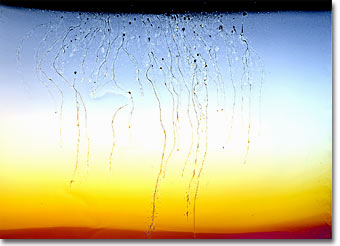Karl E. Deckart
Soap Bubble Gallery: Image Thirteen
German photographer and artist Karl E. Deckart is known for his thorough, precise, and beautiful work both in photography through the microscope and with macro camera systems. This gallery of interference photographs made with soap films is a testament to both Deckart's skill as a photographer and his understanding of the physical phenomena that surround our everyday lives. Presented below is soap bubble image number thirteen in small format. Click on the image to download a larger version.

|
Macrophotography of thin soap films freely suspended on a 4 x 4-inch wire frame was conducted with a Linhof large-format bellows camera system utilizing 4 x 5-inch sheet film and imaged using an apo-macro Nikon large format Nikkor-AM ED 210 mm f-5.6 lens. To prepare the soap film, equal parts of water, glycerin, and dishwasher detergent are thoroughly mixed in a container until a solution containing evenly sized micelles is achieved. A freestanding film is formed by dipping the wire frame into the solution and withdrawing carefully to maintain an even film thickness and avoid disruption of material flow across the frame rails. After suspension, the film was illuminated by a reflected light source positioned a few degrees from the camera system. The light was passed through a diffusion screen to avoid bright spots and provide an even illumination across the field. No polarizers were employed in photomacrography of soap thin films. Image ©1999 by Karl E. Deckart. All rights reserved. |
Unlike animals and plants, bubbles do not contain pigment cells that confer color. Yet the surfaces of these floating, transparent spheres display splendid colors that are beautifully iridescent. This spectacular interplay of color derives from the principle of light interference. When incoming light strikes the filmy bubble surface, some of the waves are immediately reflected, while others continue through to the bottom layer of the soapy film. After being reflected from the second layer, the light then retraces its passage to eventually rejoin the first rays. If the reunion is harmonious, as when the light rays coincide crest-to-crest and valley to valley, they recombine to create iridescent color. Such a union is said to occur between light rays that are in phase and the process is called constructive interference. The rays may, however, be out of step, canceling each other through destructive interference. Often, just before a bubble is ready to burst, the swirls covering its surface will appear black when held against a dark background.
BACK TO THE SOAP BUBBLE GALLERY
